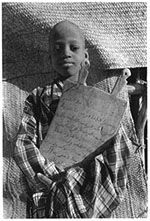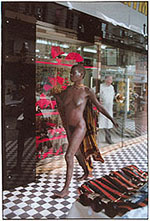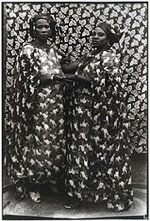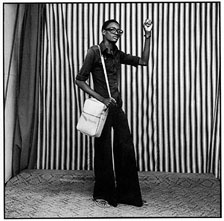 |
 |
 |
 |
 |
Roll
over images for captions
March
2002
Since the early 1980s interest in African photography
has been steadily growing in Europe and especially in
France for geographical, political and linguistic reasons.
The cultural trend has been highly visible in several
magazines devoted to African culture, such as the glamorous,
large-format Revue Noire (also a book publisher) and in
exhibitions at Paris’s Musée des Arts Africains
et Océaniens, London's Barbican Gallery and other
museums in Rome, Munich and Vienna.
Then in the last seven years, interest in African photography
has crossed the Atlantic Ocean. The most recent import
is Flash Afrique,
a small but ambitious book of essays in English and photographs
which is the companion to a traveling exhibition that
originated at Vienna's Kunsthalle.
Some of the photographers featured in Flash
Afrique have exhibited to much acclaim in Boston,
Chicago, Washington and New York, as well as in Europe.
Flash Afrique endeavors
to investigate the representations of West African realities
ranging from studio pictures to documentary photographs
as well as more private imagery that draws on reflections
and dreams.
Because of its colonial past, West Africa has always been
a territory of projections and misunderstandings. Conscious
of this, the curators of Flash Afrique are faithful to
their goal that the show and book not be a reconstruction
from the curators’ point of view or a projection
of Western desire, but tell one of many African stories
through voices of artists and curators.
The stories are of photographers who do studio work such
as Seydou Keita from Mali and Philip Kwame Apagya from
Ghana, and the documentary tradition from Dakar and Abidjan,
where photo agencies have sprung up since 1989, because
they can supply local news and reportage at a much lesser
cost than their European colleagues. Photographers such
as Bouna Medoune Seye from Senegal, who now resides in
Paris ( "Les trottoirs de Dakar"/Dakar's sidewalks)
and Morris Haron Kasco from the Ivory Coast ( "Les
fous d'Abiddjan"/ mad people from Abidjan) belong
to that fresh and direct tradition and bring into the
saddest subject matter a very African sense of humor and
play.
Somewhere in between studio and documentary, the personal
and lyrical work of Malik Sidibé from Mali and
Boubacar Touré Mandémory from Senegal explore
dreams and reflections and draw on a mix of African and
modern traditions.
All in all, Flash Afrique delivers what its title promises:
a brief but exceptional illumination of West African photography.
-- Carole Naggar
(1) "African photographers,"
Guggenheim Museum, New York,1996, Africa by Africa at
the Barbican Gallery ,London, 1999.
Flash
Afrique, Photography From West Africa.edited
by Gerald Matt, Thomas Miesgang, Kunsthalle Wien and published
by Steidl, Gëttingen, Germany,2001.
The most important publication to date on African photography
is Pascal Martin Saint-Léon's Anthologie de la
photographie africaine et de l'Océan
Indien (Anthology of Photography from Africa and the Indian
Ocean) Paris, Revue Noire ed.,1998. With short English
translations and over a hundred illustrations. |
|
|

|
|



